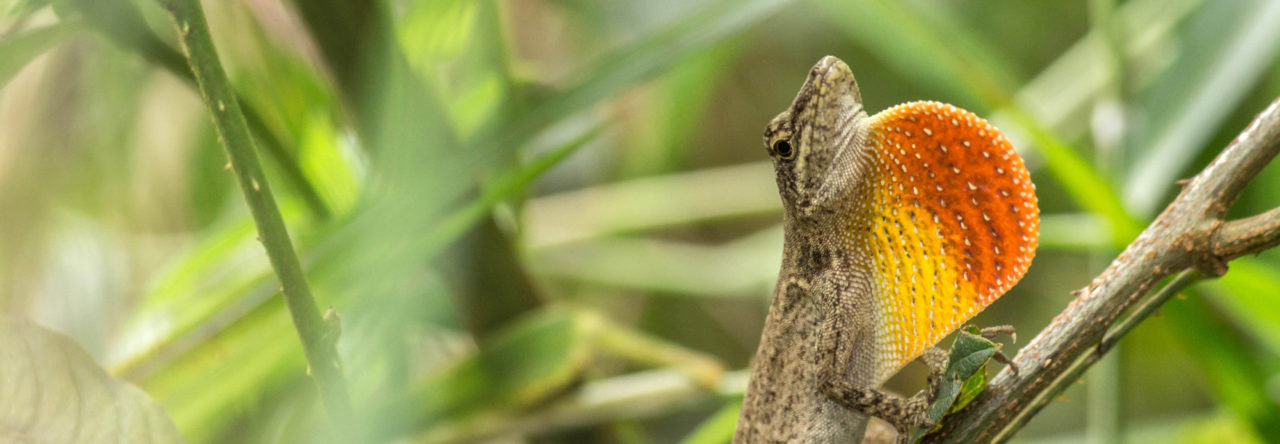httpv://www.youtube.com/watch?v=5Yk4szOOaFg
I had spent a summer in Florida watching green and brown anoles jump around on trunks and branches, and I was amazed by how well they appeared to navigate their habitat, despite the variable flexibility and complexity of the habitat. Many anole species jump. They jump to move around their habitat, to forage, to fight, to chase (or be chased by) potential mates, and to avoid predators. If you have observed anoles jumping in the wild, you might notice that some species jump a lot, and they jump to and from a lot of different types of structures (the ground, trunks, branches, leaves). While the diameter of different types of structures has been shown to affect running speed and surefootedness, it has also been shown to have little impact on jumping, at least in the lab. But what about the flexibility (compliance) of the structures they are jumping to and from? Will a narrow branch in the wild affect jumping performance, not because of its diameter, but because narrow branches tend to be flexible? What about other flexible structures in nature, such as leaves, which tend to be wide and highly flexible? And, are anoles choosy about where, and from what, they jump?
It turns out, when it comes to jumping, perch flexibility is quite important.
With the help of my advisor, an engineer, and a generous collaborator who gave me guidance and let me use his specially-designed anole jumping tank, we conducted a lab study to to determine if and how perch flexibility affects jump performance in green anoles. We found that the more flexible a perch was, the more it negatively affected jump distance and jump speed. We also observed that the recoiling perches whacked the anoles in the tail as they were jumping, which caused many anoles to do an impressive faceplant (this part of the story has received a bit of notoriety, both in the Annals (twice) and elsewhere). So, increased perch flexibility decreases jumping performance in the lab. But what does this mean for those anoles I’ve seen jumping from leaves and twigs in their natural habitat?

Male green anole perched on a flexible palm leaflet
To answer this question, I headed back down to Florida and spent a little over a month filming green anole jumping behavior. The green anoles I observed in the wild appeared to be extremely choosy about which structures they jump from. While I found them basking and foraging on a range of perches, from stiff trunks to highly flexible leaves, the lizards would generally jump from the sturdiest perches in the habitat. If they were on a thin and flexible palm leaflet, they would move closer to the base of the leaflet to a stiffer spot before jumping. And when they did jump from highly flexible perches, they jumped to another perch that was just a short distance away. The longest jumps we observed were from the most sturdy (and low-lying) perches.
The green anoles I observed appeared to be so good at choosing perches to jump from, that over the course of my study I only noted two failed jumps from flexible perches. In one instance, a male was perching near the end of a leaflet, then moved to a sturdier part of the leaflet to jump onto a perch above him. Although this part of the leaflet was sturdy, it was not sturdy enough. The force of the jump pushed the jump perch down away from him, and he was unable to jump high enough to reach his intended perch. Luckily, he was able to catch onto another leaflet before he hit the ground. In the other instance, another male attempted a jump to a far perch and landed on the ground instead, then quickly climbed back up the palm. However, because I documented undisturbed behavior, many of the jumps I witnessed were sub-maximal. The lizards were jumping as far as they needed to at the time to get to another perch, but were not attempting to flee and therefore may not have been jumping as far as they might otherwise been able to. I wonder how my observations of how choosy they are with jump perches would change if they were in situations where they needed to escape quickly.
Read More








 Two days ago,
Two days ago, 



 Don McLeish has
Don McLeish has